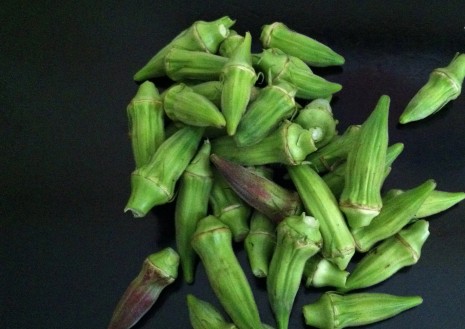OLD-WORLD OKRA
Most Americans are squeamish about viscosity, and so tend to pigeonhole okra as a quaint southern specialty. It has its place simmered in a gumbo, pickled in a spiced brine, or enrobed in a cornmeal batter and fried, they say, but still.
There is a mighty fine line between tolerant and patronizing, and what I find quaint in this day and age is such a blinkered world view. For millennia, okra has been a popular vegetable in India, Asia, the Middle East, and, of course, Africa. It originated on that continent (along with barley, wheat, sorghum, millet, and flax) in what geobotanists call the Abyssinian center of origin of cultivated plants—which includes Ethiopia and parts of Eritrea and Somaliland. One of the first descriptions of the cultivated vegetable was written by a Spanish Moor who visited Egypt in 1216.
Okra is a tropical plant that came to the Americas via the slave trade, or perhaps even earlier, with the Spanish and Portuguese. Along with cotton and hibiscus, it’s a member of the mallow family, and a dip into Will Weaver’s Heirloom Vegetable Gardening will tell you that two early areas of cultivation centered on New Orleans and Charleston. “By the latter half of the eighteenth century,” Will wrote, “okra began appearing in gardens in the Middle States, especially in the region around Philadelphia, which at one time had a large Creole population. Okra was depicted in a number of still life paintings by members of the Philadelphia Peale family during the 1820s, so it is possible to form an impression of what those old varieties were like.” There’s a very nice example, by James Peale, of what Will is talking about in the Metropolitan Museum of Art.
Heirloom okra is worth growing for the cultivar names alone—among them Stubby, Cow Horn, and the trilogy of late-19th-century okras Will calls “the three velvets”: Green Velvet, White Velvet, and Red Velvet, with its distinctive red pod.
My mother had a sunny patch in the garden that was just right for okra, and it always flourished until the first frost. The seed pods turn from tender to tough the larger they grow, so it pays to check plants every day. One of my earliest taste memories is baby okra—delicate, thimble-sized, and eaten raw, right off the plant.
Okra’s flavor is hard to pin down—it’s elusive in an asparagus-artichoke sort of way. Like those two vegetables, it’s good steamed or sautéed; larger pods are best for grilling or roasting. And like asparagus and artichokes, too, okra is delicious with nothing more than a drizzle of warm melted butter, vinaigrette, or garlicky mayonnaise.
Personally, I do not mind the fact that okra is viscous; that ooze factor translates to great body in a quick, hot sauté with tomatoes and yellow crookneck squash. (Spoon the tangle over hot buttered rice and eat immediately.) With this week’s supply, though, I was tempted to go in an Indian direction, sautéing the okra, then tossing with cumin and mustard seeds, chopped ginger, fresh hot chile, and a little lime juice.
But then I spied the jar of preserved lemons that anchors one way-back corner of the fridge, and was reminded of a recipe in the cookbook Jerusalem that I first made last summer. I thought it was just a fling, but I think it’s love. True love.
Charred Okra with Tomato, Garlic & Preserved Lemon
Adapted from Jerusalem: A Cookbook, by Yotam Ottolenghi and Sami Tamimi
The book’s hednote to this recipe mentions that Sami’s grandmother used to thread okra, like a necklace, onto a long string, hang it in a cool place, and leave it to dry. “It would later be rehydrated when cooking it in a yachne, a Palestinian meat and tomato stew, where it imparted a glorious flavor and thickened the sauce.” Yum.
A few handfuls of very fresh, very small-to-smallish okra pods, rinsed
Extra-virgin olive oil
A few cloves garlic, sliced thin
Thinly sliced preserved lemon peel (store-bought or homemade)
A handful of cherry tomatoes, halved, or wedges of small tomatoes
Chopped fresh parsley leaves, or a blend of chopped parsley and cilantro, to taste
Half a fresh (not preserved) lemon
Flaky sea salt, such as Maldon, and freshly ground black pepper
1. With a sharp paring knife, trim the okra pods, removing the stem just above the pods so as not to expose the seeds (and trigger an ooze onslaught). Heat a large cast-iron or other heavy skillet over high heat for a few minutes until it is very hot. Working in batches so you don’t crowd the pan, dry-cook the okra, shaking the pan occasionally, for about 4 minutes per batch. The okra pods should have the occasional dark blister.
2. Return all the charred okra to the pan and add a generous drizzle of olive oil, the garlic, and preserved lemon. Stir-fry about 2 minutes, shaking the pan. Reduce the heat to medium and add the tomatoes, a couple of tablespoons water, the parsley, a generous spritz of lemon juice, and a grind or two of pepper. Gently stir everything together and continue to cook until the tomatoes are warmed through, 2 to 3 minutes. Transfer to a serving dish, dress with more olive oil and a sprinkle of that beautiful flaky salt, and serve.
Posted: August 13th, 2013 under cookbooks, cooking, late summer, recipes.


